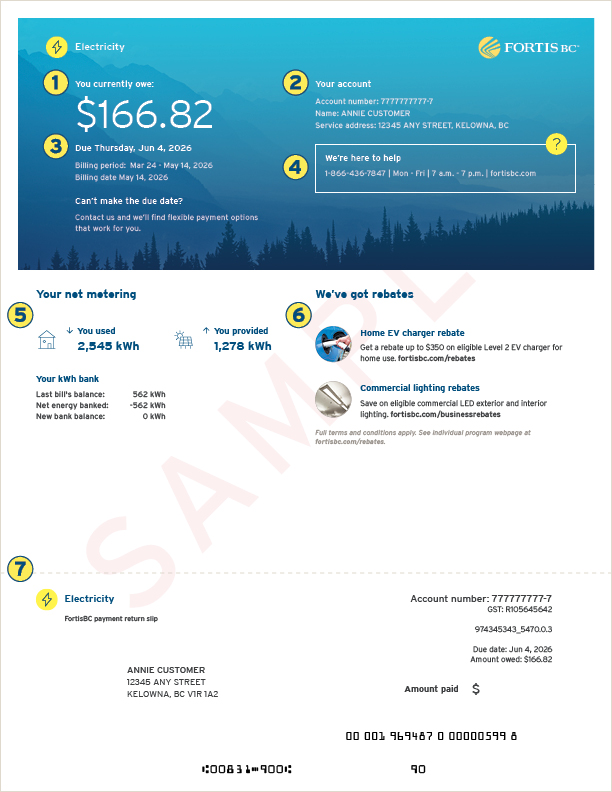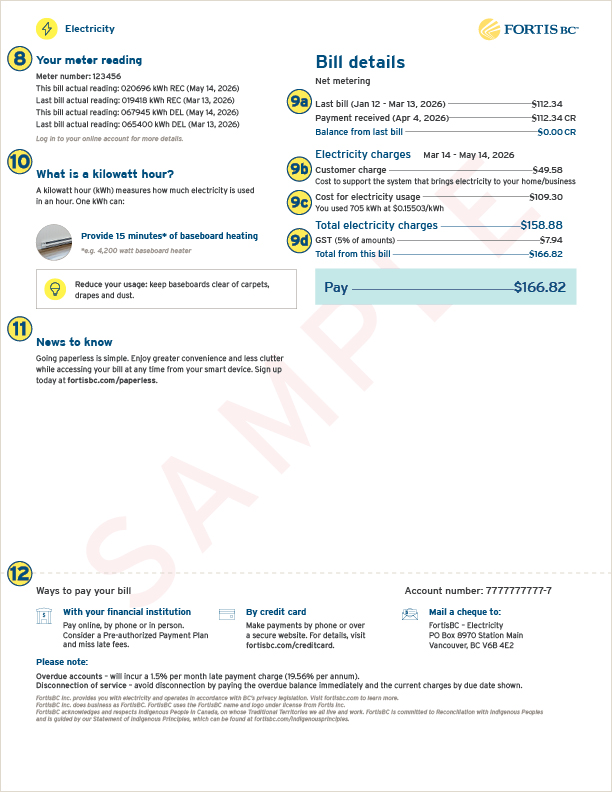Understanding your net metering electricity bill
We want to make sure your net metering electricity bill is clear and makes sense to you. Since there’s more to your bill than the amount due, we’ve created a sample bill below that explains the different items that could appear on your residential bill.


Note: this is only a sample bill and may not reflect current electricity rates.
Signed up for paperless billing? It’s a good idea to check your spam or junk email folder once in a while to ensure important emails, like your bill, don’t get missed.
1. Amount/payment due/amount to be withdrawn
This is the balance outstanding on your account from your last bill plus new charges. If the balance shown is a credit, you’ll also see a "Do not pay" alert on your bill.
2. Your account
This section includes your account number, the name your account is in and the address where you are receiving electricity service.
3. Billing dates
- Due date is the date your next payment is due.
- Billing period is the period of time in which charges are billed to your account.
- Billing date is the date your bill was issued. Transactions after this date will appear on your next bill.
4. Our contact information
We’re here to help. If you have questions about your bill, call us at 1-866-436-7847, Monday to Friday, 7 a.m. to 7 p.m., or visit fortisbc.com.
5. Your net metering
This infographic shows you at a glance how many kilowatt hours (kWh) of electricity you used in a billing period and how many you provided to FortisBC in the same billing period.
Your kWh bank is made up of three line items on your bill:
- Last bill’s balance shows the number of kWh that you had in your bank prior to any billing adjustments being made.
- Net energy banked shows the difference between how much electricity you used and how much you provided to us during a billing period. If you’ve generated less electricity than you’ve used in a billing period, you’ll see a debit amount.
- New bank balance shows the number of kWh you currently have in your bank as a result of any bill adjustment.
6. Energy-saving tips/rebate offers
On every bill you’ll see either a set of energy-saving tips or information about our rebates on high-efficiency heating equipment and products. This information could help you lower your energy use, greenhouse gas emissions and save money on your energy bills.
7. Payment return slip
This slip lists your account number, your GST number, bill due date and total amount due. If you receive a paper bill and either mail your payment or pay in person at your financial institution, please include the return slip.
8. Your meter reading
This lists your meter number and how much electricity you’ve used over the billing period. It shows your current meter reading and subtracts your previous meter reading.
Estimated or pro-rated bills
Occasionally, we’re unable to secure a reading on the scheduled date. If this happens, we will estimate your bill based on your past energy use. The next actual meter reading will adjust for any over or underestimate.
If the period between your meter readings is shorter or longer than usual (as is often the case when you connect a new service or disconnect your service) your bill will be pro-rated. Charges will be adjusted to reflect the length of the service period.
9a. Your last bill
- Last bill is the amount that was due on your last bill.
- Payment received is the last payment amount we received from you.
- Balance from last bill shows the amount owing, if any, from your previous bill and any payments or adjustments since we issued your last bill.
9b. Customer charge
This charge pays for your meter, equipment maintenance and billing. It’s a fixed charge, meaning it’s the same on every bill and not based on how much electricity you use.
9c. Cost for energy usage
Cost of energy usage is the actual amount of electricity you use in a given period.
9d. Other charges & taxes
Other charges and taxes you may see on your bill are set by various levels of government. We collect them on their behalf and don’t gain any revenue from these taxes and fees, which include:
- GST (goods and service tax) is a federal tax we collect on behalf of the federal government.
- Municipal operating fee is a levy FortisBC collects on behalf of some municipalities. This fee gets passed on to the district, municipality, city, town or village you live in. It may appear as a fee on monthly charges, excluding tax. When an operating fee is in place, the BC Utilities Commission has approved the fee. It doesn’t result in additional revenue for us. For questions about operating fees in your area, contact your local government.
10. Electricity facts
On every bill you’ll see an interesting electricity fact that will help you understand what a kilowatt hour of electricity is equivalent to—like powering a laptop computer for 40 hours.1 You’ll also get a corresponding tip to help you reduce your energy use.
11. News to know
On most bills you’ll get some news from us that we hope you’ll find valuable. It could be information about a new rebate or a reminder about how to stay safe around our energy infrastructure.
12. Ways to pay your bill
Find out about the different ways to pay your bill including by credit card, cheque or through your financial institution.
We’re here to help
Homes and businesses: 1-866-436-7847, Monday-Friday, 7 a.m. to 7 p.m.
1One kWh can power an ENERGY STAR® laptop computer with a 20" screen for 40 hours.